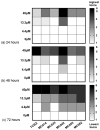Modified Hederagenin Derivatives Demonstrate Ex Vivo Anthelmintic Activity against Fasciola hepatica
- PMID: 37514055
- PMCID: PMC10385850
- DOI: 10.3390/pharmaceutics15071869
Modified Hederagenin Derivatives Demonstrate Ex Vivo Anthelmintic Activity against Fasciola hepatica
Abstract
Infection with Fasciola hepatica (liver fluke) causes fasciolosis (or fascioliasis) and poses a considerable economic as well as welfare burden to both the agricultural and animal health sectors. Here, we explore the ex vivo anthelmintic potential of synthetic derivatives of hederagenin, isolated in bulk from Hedera helix. Thirty-six compounds were initially screened against F. hepatica newly excysted juveniles (NEJs) of the Italian strain. Eleven of these compounds were active against NEJs and were selected for further study, using adult F. hepatica derived from a local abattoir (provenance unknown). From these eleven compounds, six demonstrated activity and were further assessed against immature liver flukes of the Italian strain. Subsequently, the most active compounds (n = 5) were further evaluated in ex vivo dose response experiments against adult Italian strain liver flukes. Overall, MC042 was identified as the most active molecule and the EC50 obtained from immature and adult liver fluke assays (at 24 h post co-culture) are estimated as 1.07 μM and 13.02 μM, respectively. When compared to the in vitro cytotoxicity of MDBK bovine cell line, MC042 demonstrated the highest anthelmintic selectivity (44.37 for immature and 3.64 for adult flukes). These data indicate that modified hederagenins display properties suitable for further investigations as candidate flukicides.
Keywords: Fasciola hepatica; Hedera helix; anthelmintic drug discovery; saponins and hederagenin.
Conflict of interest statement
This work represents a collaboration between Bimeda Ltd., UK, Naturiol Bangor Ltd., and Ridgeway Research Ltd., each of which may have a direct or indirect financial interest in the subject matter discussed in the manuscript.
Figures







References
-
- Roberts L.S., Janovy J., Schmidt G.D. Foundations of Parasitology. 6th ed. McGraw-Hill Education; Boston, MA, USA: 2000.
-
- Alemneh T. An Introductory to Fasciolosis. Concepts Dairy Vet. Sci. 2019;2:190–194. doi: 10.32474/CDVS.2019.02.000139. - DOI
-
- McNulty S.N., Tort J.F., Rinaldi G., Fischer K., Rosa B.A., Smircich P., Fontenla S., Choi Y.-J., Tyagi R., Hallsworth-Pepin K., et al. Genomes of Fasciola hepatica from the Americas reveal colonization with Neorickettsia endobacteria related to the agents of potomac horse and human sennetsu fevers. PLoS Genet. 2017;13:e1006537. doi: 10.1371/journal.pgen.1006537. - DOI - PMC - PubMed
Grants and funding
LinkOut - more resources
Full Text Sources

